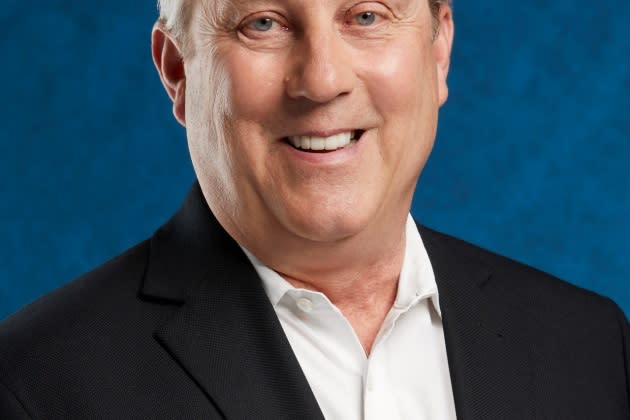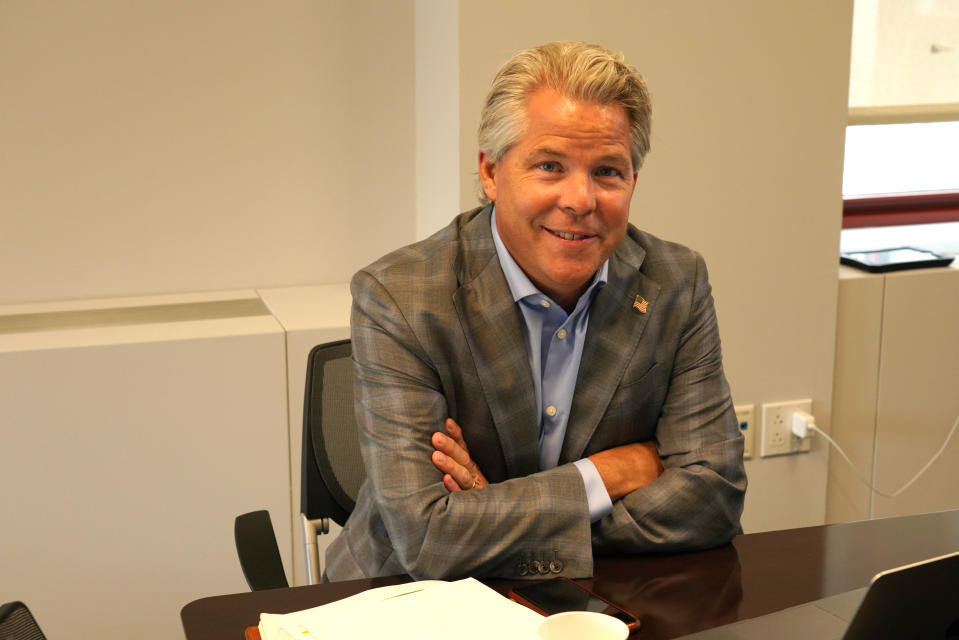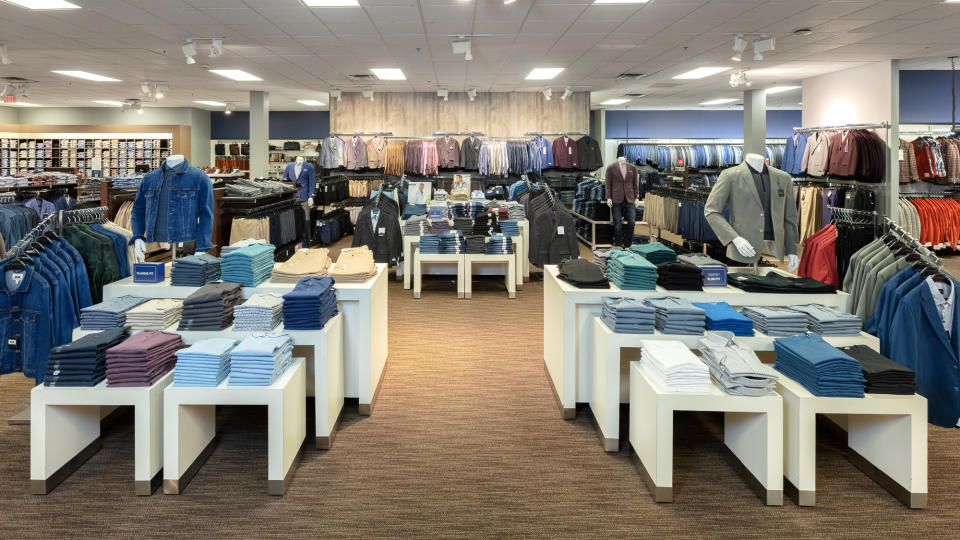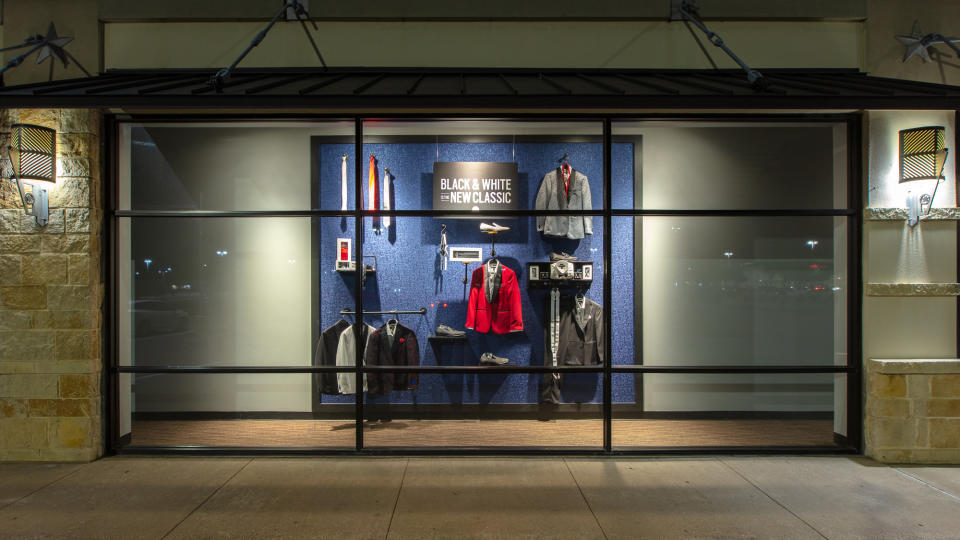Tailored Brands Team Unveils Go-Forward Game Plan

Tailored Brands has finally provided a peek behind the curtain.
In his first-sit down interview since taking the helm of the menswear retailer, co-chief executive officer Peter Sachse said the company has been stabilized and is performing well as it zeroes in on its historic strength as a tailored clothing and tuxedo business.
More from WWD
Since taking over, and bringing John Tighe on board as president and chief merchant, there is no part of the business that hasn’t been touched — from the assortment, merchandising and marketing to the pricing and promotional strategy.
And it’s working.
Earlier this month, Tailored Brands, which operates Men’s Wearhouse, Jos. A. Bank, Moores and K&G Superstores, received upgrades from both Moody’s Investors Service and Standard & Poor’s. Moody’s moved the company up three notches from Caa1 to B1 with a stable outlook, prompting Mike Zuccaro, vice president of Moody’s, to write: “The upgrades reflect the substantial improvement in Men’s Wearhouse’s operating performance, credit metrics and liquidity since the company exited Chapter 11 bankruptcy in December 2020. We expect the company to maintain solid credit metrics and very good liquidity over the next 12-18 months despite the very challenging environment.”
S&P also upgraded the company to a B-minus rating from a CCC-plus after its operating performance exceeded expectations. S&P projected the company will hit sales of $2.6 billion over the next 12 months.
Its latest update, which is posted on the Tailored Brands website, links to a story on Reorg.com that said revenue in the fourth quarter rose 96.5 percent to $557.6 million spurred by demand for tuxedo rentals for weddings. Adjusted EBITDA swung to positive $50.9 million from negative $123.1 million for the fourth quarter of 2020.
“We’re a private company and we don’t release numbers,” Sachse said, “but almost all of our nearly 1,000 stores are now four-wall profitable.”
In March of this year, Sachse and Bob Hull were officially named co-CEOs for the Houston-based menswear retailer. Sachse and Hull had served on the company’s board and stepped up to the interim co-CEO roles in March of 2021 when then-CEO Dinesh Lathi stepped down. Tighe joined two months later.
All of the men have extensive management experience. Sachse spent 34 years at Macy’s, Inc. in roles including chief stores officer, chief marketing officer and chairman and CEO of the company’s e-commerce division. Hull spent 17 years at Lowe’s Companies, which included 14 years as chief financial officer, and Tighe had a long career at J.C. Penney that included its head of menswear as well as its as chief merchant and he was also president of Peerless Clothing until he joined Tailored Brands.

“We had the opportunity to spend 60 or 90 days doing due diligence to see if we wanted to join the board,” Sachse told WWD in an interview in the company’s Seventh Avenue offices. “So we had a pretty good understanding of what we were coming into. We didn’t have a strategy and didn’t know exactly what we were going to do, but the due diligence period was incredibly helpful and allowed us to hit the ground running. We weren’t complete novices so we had a point of view of where to go.”
Lathi, who had been CEO since March of 2019 took over for long-time chief Doug Ewert who retired in September of 2018. From the moment he took over the top spot, he was highly critical of former management, who soon after either left or were pushed out. He said the business had not evolved with the times, was too promotional and too heavily dependent on tailored clothing.
Lathi instituted a dramatic restructuring to change these perceived ills, but the pandemic pushed the company into Chapter 11 bankruptcy in August 2020. It exited the proceedings in December of that year but had to go back to its lenders to secure $75 million in financing in order to continue operating. Following Lathi’s departure, his team, which included Carrie Ask, chief merchant and customer officer, also left the company.
Sachse said that the Tailored Brands of today is a different company than it was in the past. And while the management team maintains a healthy respect for the past — the firm was founded by George Zimmer in 1973 — it is committed to moving it forward into the future.
“The company had great roots and a wonderful DNA,” Sachse said. “It had a selling culture that was as good as any in the industry. It just needed to have a vision and a purpose on where to go next. So and that’s what we tried to bring in — new thinking.”
Eight of the 10 people on the executive committee are new, he said, including Tighe, as well as the head of stores, IT, legal and the chief financial officer. “And Bob and I are new.”
Tighe said when he joined the company, he was “pretty familiar with the company by being a competitor and then being a supplier. So for years, I had a great appreciation for the model, the service that the company provided within the industry, and the team which is what really drove the business.”
On top of that, Tighe said he was “a firm believer in tailored clothing. I know a lot of companies were avoiding the category but I thought if we dressed people to look great for the most important events in their lives, we could be wildly successful.”

Although the former management team had been moving the business into more sportswear and even ath-leisure, a move that Tighe and the team put the brakes on immediately.
“We’re still mostly dressing people for the important events in their lives,” Tighe said. “The way we look at it is that there are two main journeys: getting people ready for weddings and helping people look appropriate for work. That used to be a suit, but now it’s something between a suit and sweatpants, and is more refined.”
Sachse added: “We’re never going to be Nike or Lululemon — and we don’t want to be. Things were going a little bit in that direction when John and I got here and we quickly got rid of that. Whether it’s a bar mitzvah, a graduation, a new job interview — we are the authority. And it’s not just the groom and the groomsmen, but the guests too, because they have to get dressed up. We’ve got an enormous market share. We help people love the way they look and feel for their most important moments.”
That tagline should be familiar. Zimmer gravelly delivery of: “You’re going to like the way you like, I guarantee it” defined the business for decades.
Tailored Brands’ new version is similar but intentionally not a replica, with “You’re going to Love it” as the new tagline. Sachse said: “We think love is a stronger word than like. So whether you’re going to work or to grandma’s funeral, you’re confident you’ll look good.
“Our entire vision is not to give up what the company was built on,” he continued. “We’re not ashamed of the past, we just need to modernize it.”
Speaking about the flagship Men’s Wearhouse division, the executives said that there is no other retailer that can offer customers the option to buy, rent or create a custom garment, offer a tailor in every location and also deliver an omnichannel experience in locations around the country. Men’s Wearhouse still produces custom clothing at the company-owned factory in New Bedford, Mass., for the Joseph Abboud suits and suit separates, while the lower-priced Joe custom clothing is made in India and Mexico.
The Men’s Wearhouse stores are also in the midst of getting a facelift. During the bankruptcy, the company closed 400 stores — 200 of them Jos. A. Bank units — so the remaining locations are now profitable. “We have started the process of refreshing stores,” Tighe said. At Men’s Wearhouse, “we reset all of the stores to be more customer-centric and organized by fit.” As a result of intense customer research, Tailored Brands found that shoppers were frustrated by the sheer volume of merchandise and the way it was displayed.
“You no longer will walk into a Men’s Wearhouse store and see 3,000 sleeves, shoulder hung, where you’re incapable of getting your hands in between any of the sleeves, because there are so many,” Sachse said. “Now we have organized the store by classic, or slim, or updated.”

Of the 630 Men’s Wearhouse stores, 100 percent have been “remerchandised top to bottom,” Sachse said, and several have been remodeled. “We’re taking a series of stores and refreshing them, updating them with a bit of a renovation and organizing them to be more modern,” Tighe said. “We’re going to end up doing about 50 stores this year, and then that’ll progress as we move through the future.”
As far as brands are concerned, Men’s Wearhouse remains the exclusive U.S. supplier of the Joseph Abboud collection, a label that it once owned but sold to WHP Global, as well as Awearness Kenneth Cole. In addition, it carries Calvin Klein, Tommy Hilfiger and other national brands and also has several private labels such as Pronto Uomo. The mix at Moores is similar while Jos. A. Bank is nearly 100 percent private label. K&G offers a value assortment that is a completely different animal.
Sachse said that both K&G is actually the strongest performing division of the company, but Moores and Jos. A. Bank are performing well, although the rebound in the Canadian market was slower than that of the U.S. “But they’re all doing fine.”
The weakest link continues to be Jos. A. Bank, but because the company closed 200 stores in the fleet during the bankruptcy, all of the stores in every division will be profitable this year.
“We got a chance to start over,” Sachse said of the company as a whole, “and rationalize our pricing and promotions.” Tailored Brands has embraced a good, better, best strategy, and instead of the “buy one get one free” that characterized the business in the past, Tighe and the merchandising team “optimized and simplified the pricing throughout the chain,” Sachse said. “There probably is not one garment in the store that we didn’t touch on prices. Do we still promote? Yes, but not nearly at the depth, or the frequency that we did before. In this business, it’s rare that you get a chance to start over, but we started with a clean slate, and this is the kind of business we like to run.
“There’s nothing in this company other than the DNA that is the same,” he continued. “The merchandise assortment has changed dramatically. We used to be 70 percent vested suits, now we’re just short of zero. In our separates, we had unhemmed pants, but the customer wanted hemmed. The way we merchandise the stores is completely different, the way the store is priced is completely different, the way the stores gets marketed is completely different.”
Looking ahead, the team is banking on three pillars to drive future success. The first is to be customer-centric and empower associates to go above and beyond to meet shoppers’ needs. The second is a retail revolution, which addresses how to most effectively source, buy and sell goods and enhance the digital experience, a category that is underdeveloped at the company. And the third is operational excellence.
“There’s a huge opportunity for us to really become a world-class omni retailer,” Tighe said. Sachse said online sales are Jos. A. Bank are in the double digits, but only in the single digits at Men’s Wearhouse and Moores. Continued e-commerce innovation is on the to-do list along with some other changes such as the introduction of a planning tool for grooms this fall, similar to that from The Knot and other women’s-centric brands. It will be called The Wedding Wingman.
“We’re investing up to $75 million this year to make this company strong for the future,” Tighe said. “It’s not all technology, but there’s a lot of catch-up there. And it’s already started showing significant green shoots so that’s going to be a great growth engine for the company as we continue to evolve.”
Both executives believe the future is bright for Tailored Brands but know that there’s still work to be done. And the executive team is banking on its staff to help it reach its goals.
“None of this is possible without the team,” Sachse said. “We’ve got a really good, dedicated, enthusiastic team — one of the best in the business. That’s the people that we hired last year and the people that were here already. They’ve been inspired by this strategy and they’re rising to the occasion. We talk about the strategy in terms of phases. We’re a good company, but how do we get to be great? And once we’re a great company, how do we be legendary?”
In fact, next to the company’s name on internal documents are the words: Be Legendary, and the team will continue to work to reach that goal.
Sachse said: “It’s a wonderful mantra and a wonderful path to send an entire organization.”

